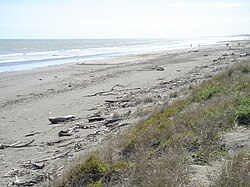
Summary
Peka Peka, sometimes spelled Pekapeka, is a seaside locality[3] on the Kāpiti Coast of New Zealand's North Island. It is located just off State Highway 1 and the North Island Main Trunk railway between Waikanae and Te Horo.
Peka Peka | |
|---|---|
 Peka Peka Beach, looking north | |
 | |
| Coordinates: 40°49′58″S 175°03′29″E / 40.8327°S 175.0581°E | |
| Country | New Zealand |
| Region | Wellington Region |
| Territorial authority | Kāpiti Coast District |
| Ward | Waikanae Ward |
| Community | Waikanae Community |
| Electorates | |
| Government | |
| • Territorial Authority | Kāpiti Coast District Council |
| • Regional council | Greater Wellington Regional Council |
| • Kāpiti Coast Mayor | Janet Holborow |
| • Ōtaki MP | Tim Costley |
| • Te Tai Hauāuru MP | Debbie Ngarewa-Packer |
| Area | |
| • Total | 10.02 km2 (3.87 sq mi) |
| Population (June 2023)[2] | |
| • Total | 700 |
| • Density | 70/km2 (180/sq mi) |
Peka Peka was briefly internationally famous when a young emperor penguin, nicknamed Happy Feet,[4] appeared on Peka Peka beach on 21 June 2011.[5] Emperor penguins are usually only found in the Antarctic.[6]
Peka Peka Beach is a clothing-optional beach by custom.[7] New Zealand has no official nude beaches, as public nudity is legal on any beach where it is "known to occur".[8]
Demographics edit
Peka Peka statistical area covers 10.02 km2 (3.87 sq mi).[1] It had an estimated population of 700 as of June 2023, with a population density of 69.86 people per km2.
| Year | Pop. | ±% p.a. |
|---|---|---|
| 2006 | 357 | — |
| 2013 | 504 | +5.05% |
| 2018 | 612 | +3.96% |
| Source: [9] | ||
Peka Peka had a population of 612 at the 2018 New Zealand census, an increase of 108 people (21.4%) since the 2013 census, and an increase of 255 people (71.4%) since the 2006 census. There were 246 households, comprising 303 males and 309 females, giving a sex ratio of 0.98 males per female. The median age was 52.1 years (compared with 37.4 years nationally), with 99 people (16.2%) aged under 15 years, 66 (10.8%) aged 15 to 29, 300 (49.0%) aged 30 to 64, and 144 (23.5%) aged 65 or older.
Ethnicities were 93.1% European/Pākehā, 6.4% Māori, 2.0% Pasifika, 3.4% Asian, and 3.4% other ethnicities. People may identify with more than one ethnicity.
The percentage of people born overseas was 24.0, compared with 27.1% nationally.
Although some people chose not to answer the census's question about religious affiliation, 58.8% had no religion, 31.4% were Christian, 0.5% were Hindu, 1.0% were Muslim, 1.0% were Buddhist and 2.0% had other religions.
Of those at least 15 years old, 168 (32.7%) people had a bachelor's or higher degree, and 54 (10.5%) people had no formal qualifications. The median income was $42,500, compared with $31,800 nationally. 159 people (31.0%) earned over $70,000 compared to 17.2% nationally. The employment status of those at least 15 was that 219 (42.7%) people were employed full-time, 99 (19.3%) were part-time, and 15 (2.9%) were unemployed.[9]
The demographics for Peka Peka are also incorporated in Waikanae#Demographics.
References edit
- ^ a b "ArcGIS Web Application". statsnz.maps.arcgis.com. Retrieved 20 May 2021.
- ^ "Population estimate tables - NZ.Stat". Statistics New Zealand. Retrieved 25 October 2023.
- ^ "Place name detail: 20 May 2021". New Zealand Gazetteer. New Zealand Geographic Board.
- ^ "New Zealand penguin Happy Feet may have been eaten". The Telegraph. Retrieved 25 January 2013.
- ^ "Kapiti's rare visit from emperor penguin". The Dominion Post Wellington. Retrieved 15 December 2011.
- ^ "Emperor penguin from Antarctic visits New Zealand beach". BBC News Asia Pacific. Retrieved 15 December 2011.
- ^ "Wellington Region". Free Beaches NZ Inc. Retrieved 28 November 2019.
- ^ Ceramalus v Police, AP No 76/91 (High Court of New Zealand 5 July 1991).
- ^ a b "Statistical area 1 dataset for 2018 Census". Statistics New Zealand. March 2020. Peka Peka (236900). 2018 Census place summary: Peka Peka


